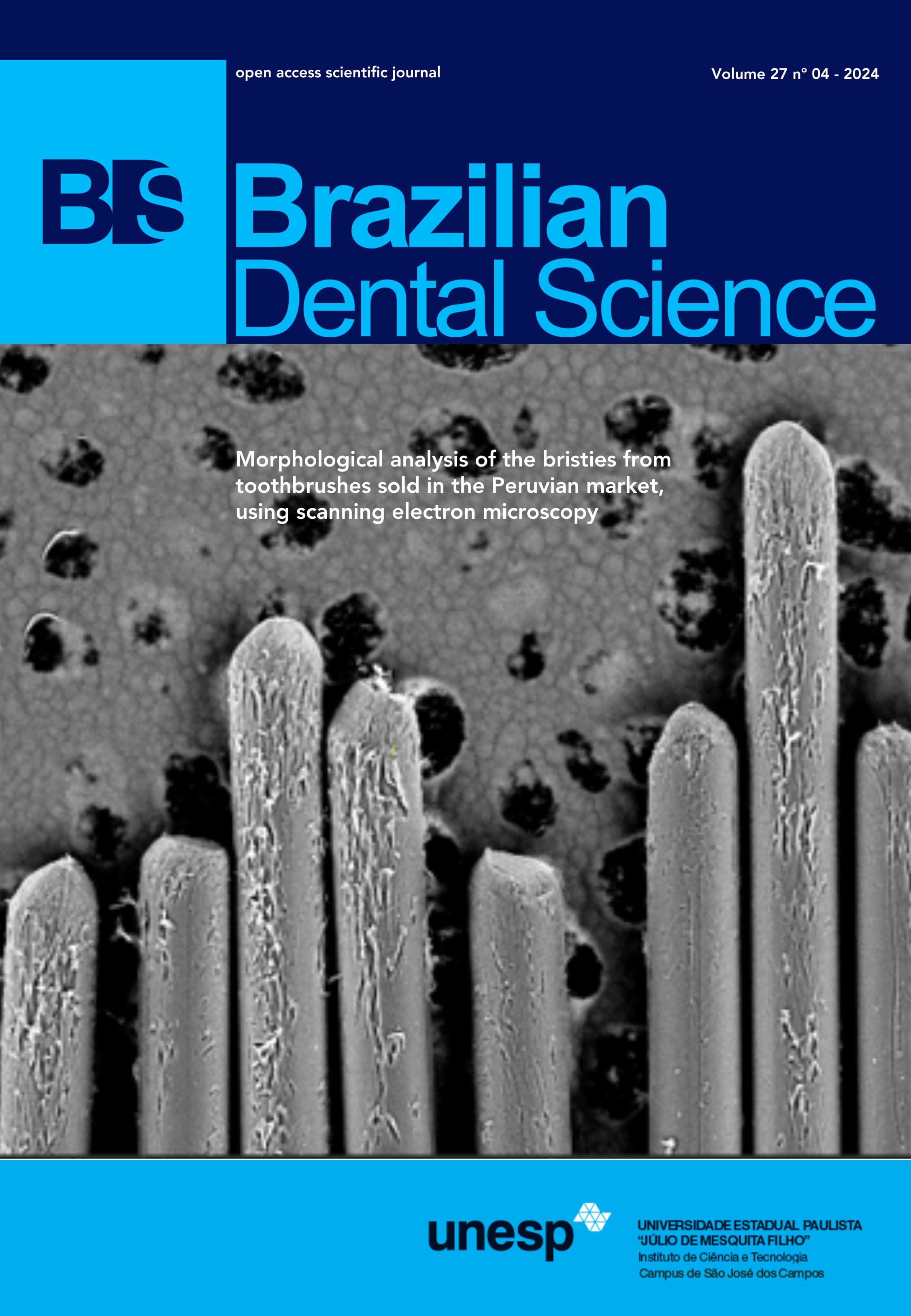The Er.Cr.YSGG laser’s impact in the occlusion of dentinal tubules: in vitro study
DOI:
https://doi.org/10.4322/bds.2024.e4472Resumo
Background: Severe discomfort due to exposed dentin that is brought on by thermal, tactile, evaporative, electrical, osmotic, or chemical stimulation is known as dentinal hypersensitivity. It typically includes the teeth’s facial surfaces close to the cervical boundary and, typically, in premolars and canines. It might be caused by either cemental or enamel loss. Objective: To assess how well the Er.Cr.YSGG laser seals dentinal tubules when it’s used on exposed dentine. Material and Methods: Twenty-nine natural posterior teeth were prepared, sectioned, cleaned, and made ready for treatment. Samples were split into groups: Group A, the group under negative control (N = 10), and Group B: Er.Cr.YSGG (Waterlase, I plus, Biolase Technology, Irvine, CA) was administered (N = 10) along with a pilot research group (N = 9). Wavelength of 2780 nm, irradiation mode is free-running pulse, power of 0.25 W, frequency of 20 Hz, pulse width of 60 micro s, time of 2 seconds, Fiber tip size: 600 micro m, non-contact mode, power density of 83.33 W/cm2 with 0% water and 0% air, fiber tip fixed on a distance of 1 mm perpendicular to the dentin surface with a clamp holder. Scanning electron microscopy (SEM) was used to analyze dentin-obstructed surfaces. A qualitative evaluation of the micrographs was conducted to analyze the shift in surface features. Data analysis was performed using (spss) software (version 26, IBM,USA) to investigate the data’s normal distribution. The Kolmogorov-Smirnov and Shapiro-Wilk tests revealed that the data had an abnormal distribution. Mann-Whitney U test was carried out to show a comparison between groups (control, laser group). Results: The data obtained from the laser group showed a large reduction in tubular diameter (0.737 micro m) as compared to the control group (3.095 micro m). The selected parameters (0.25W/2s, 83.33 W/cm2) were best to reduce and plug any exposed dentinal tubules without any indication of fissures or cracks. Conclusion: The study conclusively demonstrates that Er:Cr:YSGG laser irradiation offers a viable solution for dentin hypersensitivity by partially or completely occluding dentin tubules. Future clinical trials are warranted to further explore its efficacy.
KEYWORDS
Dentinal tubules; Er.Cr.YSGG; Hypersensitivity; Laser; Teeth sensitivity.
Downloads
Downloads
Publicado
Como Citar
Edição
Seção
Licença
TRANSFERÊNCIA DE DIREITOS AUTORAIS E DECLARAÇÃO DE RESPONSABILIDADE
Toda a propriedade de direitos autorais do artigo "____________________________________________________________________" é transferido do autor(es) para a CIÊNCIA ODONTOLÓGICA BRASILEIRA, no caso do trabalho ser publicado. O artigo não foi publicado em outro lugar e não foi submetido simultaneamente para publicação em outra revista.
Vimos por meio deste, atestar que trabalho é original e não apresenta dados manipulados, fraude ou plágio. Fizemos contribuição científica significativa para o estudo e estamos cientes dos dados apresentados e de acordo com a versão final do artigo. Assumimos total responsabilidade pelos aspectos éticos do estudo.
Este texto deve ser impresso e assinado por todos os autores. A versão digitalizada deverá ser apresentada como arquivo suplementar durante o processo de submissão.




























